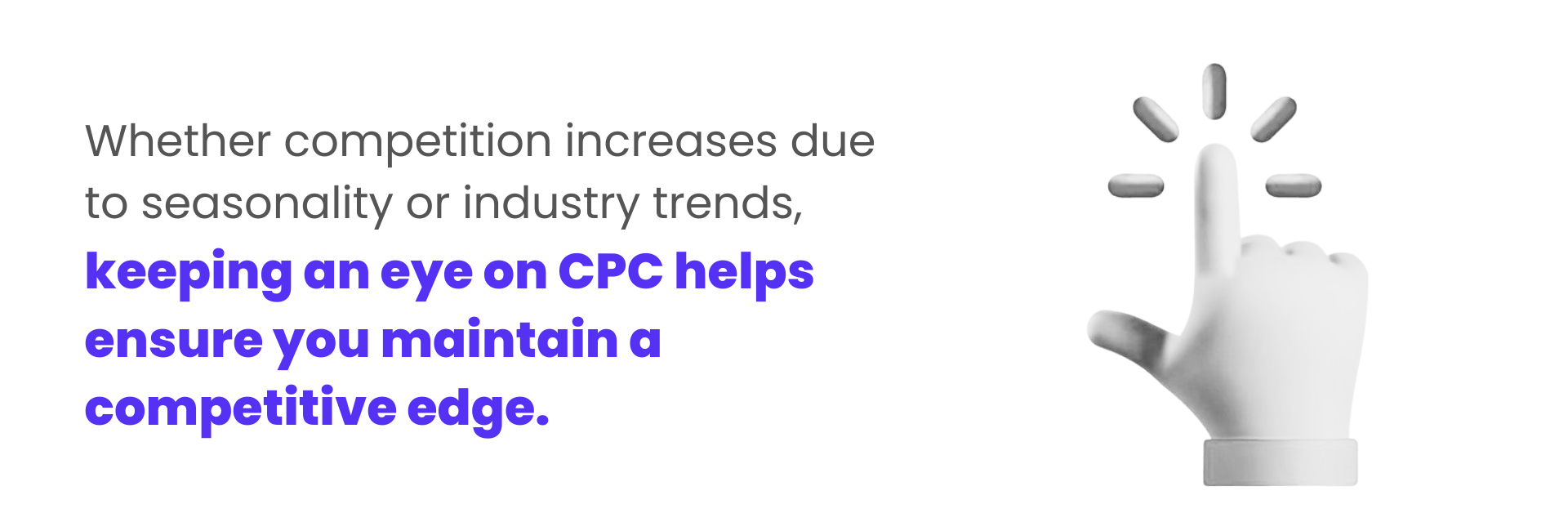
In today’s fast-paced digital world, setting and tracking the right KPIs (Key Performance Indicators) is vital for businesses looking to stay competitive and grow. Whether you’re focusing on paid media campaigns or overall business success, having clear, actionable KPIs is essential for measuring performance and ensuring that your marketing efforts are aligned with your goals.
Measuring PPC (Pay-Per-Click) success can be challenging, especially if your team lacks clarity on the right metrics. Similarly, understanding whether your business initiatives are performing well without the right KPIs can lead to wasted time, misaligned goals, and missed opportunities.
In this article, the PPC team at Digital Freak break down five key KPIs to measure paid media success and five KPIs to track business success, giving you a roadmap to align your marketing efforts with broader business objectives and drive measurable growth.
5 KPIs to Track for Paid Media Success
1. Cost Per Click (CPC)
Formula: CPC=Clicks/Impressions
Cost Per Click (CPC) is a key metric in paid media that reflects how much you’re paying each time a user clicks on your ad. While CPC doesn’t directly measure bottom-line performance, it’s a useful early indicator of how well your campaign is performing against the competition.

A rising CPC could indicate increased competition for your target keywords, suggesting a need to adjust your targeting strategy or budget. By tracking CPC over time, such as weekly or monthly, you can understand fluctuations in the competitive landscape and react proactively. Whether competition increases due to seasonality or industry trends, keeping an eye on CPC helps ensure you maintain a competitive edge.
2. Impression Share (IS)
Formula: IS = Total Impressions/Total Available Impressions
Impression Share (IS) measures the visibility of your ads compared to the total possible impressions they could receive. While not always a top KPI, it provides valuable insights into how well your ads are competing in the marketplace.
A low impression share can mean your ads are limited by budget or ad rank. This metric helps highlight where optimisations are needed. If you’re losing impression share to budget, it’s worth reassessing your budget allocation. If it’s due to rank, improving ad quality or increasing bids might be necessary.
By understanding impression share, you gain insights into potential budget shortfalls or quality issues, helping you adjust your strategy to capture more of your target audience.
3. Click-Through Rate (CTR)
Formula: CTR=Clicks/Impressions
Click-Through Rate (CTR) is a straightforward metric that shows how engaging your ads are. A high CTR indicates that your ads resonate with your target audience, while a low CTR suggests there may be a mismatch between your ad copy, targeting, or landing page experience.
CTR is a useful diagnostic tool that helps you fine-tune your campaigns. By analysing CTR at a granular level, such as by keyword or audience segment, you can identify areas where performance is strong or weak and optimise accordingly. Combining historical data with real-time performance helps you set realistic CTR-based KPIs that reflect achievable goals for the future.
4. Cost Per Acquisition (CPA)
Formula: CPA=Total Cost/Acquisitions
Cost Per Acquisition (CPA) tracks how much it costs to acquire a customer or lead through your paid media efforts. Setting CPA KPIs depends on how you define “acquisition.” Whether it’s a lead form submission or an eCommerce purchase, CPA helps you gauge how efficiently your ad spend is being used.
Tracking CPA across various stages of the user journey gives a clearer picture of performance. For instance, if your CPA is higher at the top of the funnel but lower at the bottom, you might be targeting high-quality leads that result in valuable conversions. Setting CPA targets based on historical data and understanding your product or service’s profitability ensures you maintain a balance between spending and acquisition quality.
5. Conversion Rate (CVR)
Formula: Conversion Rate=Conversions/Clicks
Conversion Rate (CVR) measures the percentage of users who complete a desired action after clicking on your ad. Whether it’s making a purchase or filling out a contact form, CVR is one of the most critical KPIs for assessing paid media success.
Tracking CVR at various stages in the funnel helps you identify where users drop off and where messaging or user experience needs improvement. For example, if CVR is low early in the funnel, prospects may require more nurturing before converting. Setting realistic CVR targets helps ensure your campaigns drive meaningful results.

5 KPIs to Track for Business Success
While measuring paid media performance is essential, you also need to set KPIs at the business level to ensure overall success. These KPIs often overlap with marketing metrics but offer a broader view of how well your business is performing.
1. Conversion Rate (CR)
At the business level, conversion rate goes beyond just paid media. It reflects the effectiveness of your entire sales process and how well your offerings meet customer needs.
By comparing conversion rates across different channels, such as paid media, outbound marketing, and direct outreach, you can identify opportunities for improvement. For example, if your paid media conversion rate is much higher than that of other channels, it could indicate that other strategies aren’t aligned with customer expectations.
2. Customer Acquisition Cost (CAC)
Customer Acquisition Cost (CAC) measures the total cost of acquiring a customer, considering marketing spend, sales costs, and vendor expenses. It’s crucial for budgeting and forecasting, as well as assessing the long-term sustainability of your business model.
Tracking CAC helps you identify which marketing and sales efforts are the most cost-effective, allowing you to optimise your budget. By monitoring CAC across different channels and campaigns, you can make data-driven decisions that align with profitability.
3. Return on Investment (ROI)
While Return on Ad Spend (ROAS) focuses on the revenue generated from advertising efforts, ROI offers a broader perspective. It measures profitability across all aspects of the business, including operations, staffing, and overhead.
ROI gives you a clear picture of the financial health of your business and helps prioritise investments that yield the highest returns. It’s essential to include all costs when calculating ROI to get an accurate view of profitability.
4. Customer Lifetime Value (LTV)
Customer Lifetime Value (LTV) estimates the total revenue a business can expect from a customer over the course of their relationship. LTV is a powerful KPI for long-term growth, as it provides insights into customer retention and satisfaction.
By tracking LTV, you can justify adjustments to your CAC KPIs. If your LTV exceeds your CAC, you know you’re acquiring valuable customers who contribute to the business over time. This helps you prioritise efforts that attract high-value customers and make data-driven decisions about scaling.
5. Payback Period
The payback period measures the time it takes to recover the costs associated with acquiring a customer. A shorter payback period means your business recoups its investment faster, allowing you to reinvest in growth initiatives.
By aligning payback period KPIs with CAC and LTV, you can gauge the overall efficiency of your customer acquisition strategy. A long payback period may indicate inefficiencies in your marketing or sales process, prompting a need for optimisation.
The Importance of Setting the Right KPIs
Whether you’re tracking KPIs for paid media or business success, consistency is key. KPIs should be based on accurate historical data and aligned with overall business goals. Changing KPIs too often or relying on unrealistic targets can lead to confusion and misalignment, reducing team performance and cohesion.
By strategically selecting KPIs and ensuring that everyone on the team understands their role in achieving them, you can create accountability and drive continuous improvement. With the right KPIs in place, your business can align marketing efforts with overall objectives, fostering growth and success.
Ultimately, KPIs are not just metrics—they’re a roadmap for performance. By tracking them consistently and making informed decisions based on data, you can ensure your paid media campaigns and business initiatives are moving in the right direction.

Make Your Ad Spend Work Harder!
At Digital Freak, we understand that effective PPC campaigns require more than just setting up ads and watching them run. It’s about aligning your paid media efforts with clear, actionable KPIs to drive real, measurable results. Our expert PPC team works closely with you to ensure your campaigns are optimised for success, leveraging metrics like CPC, CTR, CPA, and ROAS to fine-tune your strategy at every stage.
When you partner with Digital Freak, you gain more than just technical expertise—you get a team that’s committed to understanding your unique business goals and delivering growth that aligns with your vision. Whether you’re looking to boost conversions, lower acquisition costs, or maximise your return on ad spend, our PPC team is here to guide you every step of the way. Let’s work together to turn your paid media efforts into powerful tools for achieving business success.
Reach out today for a free strategy consultation and discover how Digital Freak can push the results of your PPC campaigns to the next level!
FAQS
What are KPIs and why are they important for paid media?
KPIs (Key Performance Indicators) are measurable values that track the performance of your campaigns. In paid media, KPIs like Cost Per Click (CPC) and Click-Through Rate (CTR) help determine how effectively your ads are driving traffic and conversions, ensuring you optimise spend and maximise ROI.
What is a good Click-Through Rate (CTR) for my paid media campaigns?
A good CTR varies by industry, but generally, anything above 2% is considered strong. However, instead of focusing on industry benchmarks alone, compare your current CTR to your past performance to assess improvement over time. A rising CTR means your ads are resonating with your audience, getting you more leads and sales!
How do I lower my Cost Per Acquisition (CPA)?
To lower your CPA, our PPC agency in Melbourne recommends that you focus on optimising your ad targeting, improving landing page experiences, and refining your messaging. By improving conversion rates and targeting high-intent audiences, you can reduce the amount spent on acquiring each customer.
How do I track Customer Lifetime Value (LTV) effectively?
To track LTV, our PPC agency in Melbourne recommends that you monitor customer behaviour over time, including repeat purchases, subscription renewals, and upgrades. Using CRM tools can help you calculate LTV based on the average revenue generated by a customer during their relationship with your business, helping you understand the long-term value of your customer base.
What’s the best way to balance short-term and long-term KPIs?
To balance short-term and long-term KPIs, set immediate goals (e.g., increasing conversions or lowering CPA) alongside broader business KPIs (e.g., boosting LTV or improving ROI). This dual focus ensures that while you’re hitting short-term wins, you’re also contributing to long-term business growth. Need help? Get a free PPC strategy call now!
The post Is Your PPC Working? Essential KPIs to Track Success! appeared first on Digital Freak.
#seotips #seo #digitalmarketing #searchengineoptimization #seoexpert #seoservices #seomarketing #digitalmarketingtips #marketing #seotools #seoagency #seostrategy #contentmarketing #socialmediamarketing #google #digitalmarketingagency #searchenginemarketing #onlinemarketing #socialmedia #onpageseo #website #marketingtips #seotipsandtricks #searchengineoptimisation #searchengine #digitalmarketingstrategy #googleranking #offpageseo #keywords #webdesign



